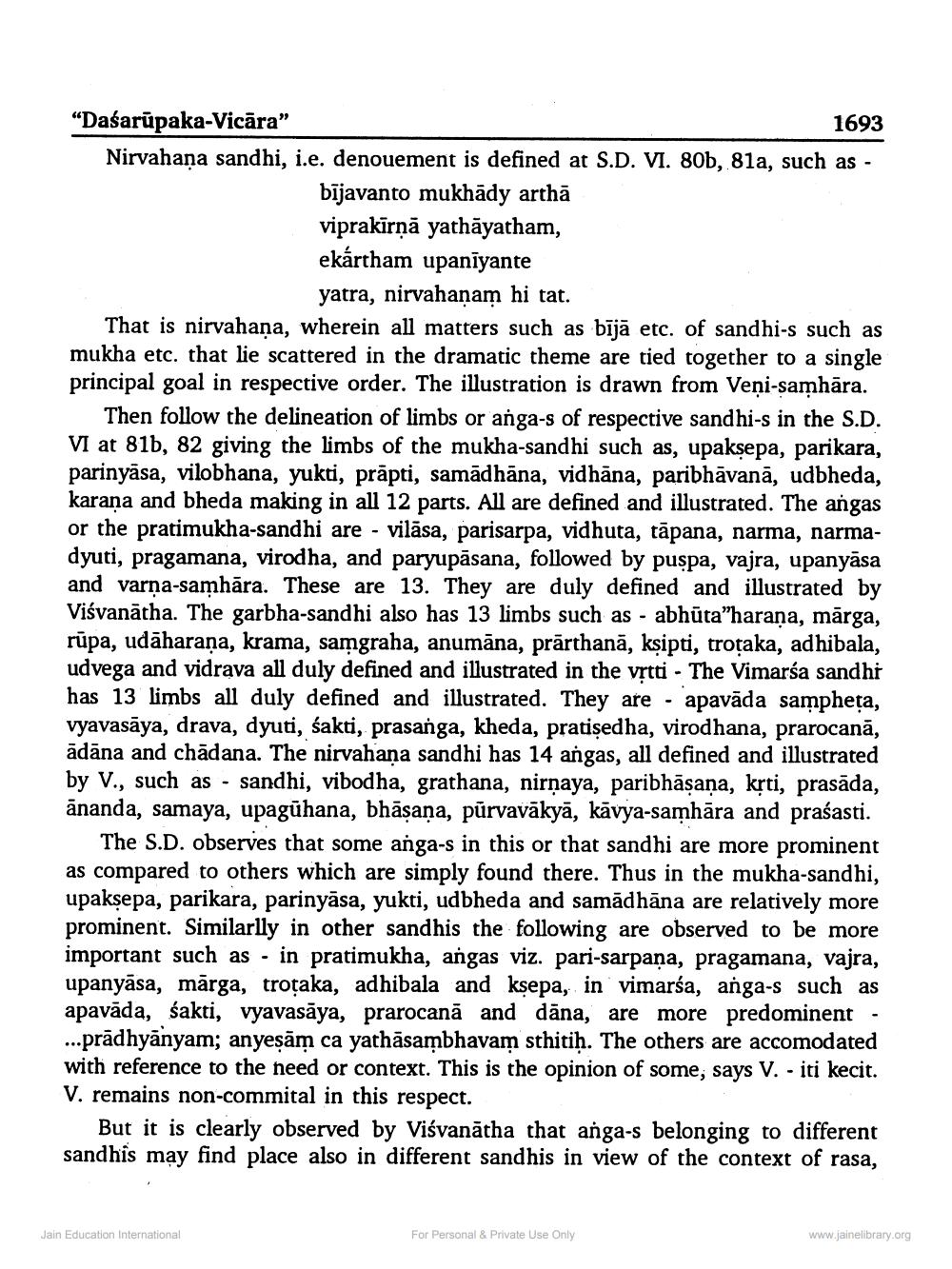________________
"Dasarūpaka-Vicāra"
1693 Nirvahana sandhi, i.e. denouement is defined at S.D. VI. 800, 81a, such as -
bījavanto mukhādy arthā viprakīrṇā yathāyatham, ekártham upanīyante
yatra, nirvahanam hi tat. That is nirvahana, wherein all matters such as bijā etc. of sandhi-s such as
ha etc. that lie scattered in the dramatic theme are tied together to a single principal goal in respective order. The illustration is drawn from Veni-samhāra.
Then follow the delineation of limbs or anga-s of respective sandhi-s in the S.D. VI at 81b, 82 giving the limbs of the mukha-sandhi such as, upaksepa, parikara, parinyāsa, vilobhana, yukti, prāpti, samādhāna, vidhāna, paribhāvanā, udbheda, karana and bheda making in all 12 parts. All are defined and illustrated. The angas or the pratimukha-sandhi are - vilāsa, parisarpa, vidhuta, tāpana, narma, narmadyuti, pragamana, virodha, and paryupāsana, followed by puspa, vajra, upanyāsa and varna-samhāra. These are 13. They are duly defined and illustrated by Viśvanātha. The garbha-sandhi also has 13 limbs such as - abhūta”harana, mārga, rūpa, udāharana, krama, samgraha, anumāna, prārthanā, ksipti, trotaka, adhibala, udvega and vidrava all duly defined and illustrated in the vștti - The Vimarśa sandhi has 13 limbs all duly defined and illustrated. They are - apavāda sampheta, vyavasāya, drava, dyuti, śakti, prasanga, kheda, pratiședha, virodhana, prarocanā, adāna and chādana. The nirvahana sandhi has 14 angas, all defined and illustrated by V., such as - sandhi, vibodha, grathana, nirnaya, paribhāșana, krti, prasāda, ānanda, samaya, upagūhana, bhāșana, pūrvavākyā, kāvya-samhāra and praśasti.
The S.D. observes that some anga-s in this or that sandhi are more prominent as compared to others which are simply found there. Thus in the mukha-sandhi, upaksepa, parikara, parinyāsa, yukti, udbheda and samadhāna are relatively more prominent. Similarlly in other sandhis the following are observed to be more important such as - in pratimukha, angas viz. pari-sarpana, pragamana, vajra, upanyāsa, mārga, troţaka, adhibala and ksepa, in vimarśa, anga-s such as apavada, sakti, vyavasāya, prarocanã and dana, are more predominent - ...prādhyānyam; anyesām ca yathāsambhavam sthitih. The others are accomodated with reference to the need or context. This is the opinion of some, says V. - iti kecit. V. remains non-commital in this respect.
But it is clearly observed by Viśvanātha that anga-s belonging to different sandhis may find place also in different sandhis in view of the context of rasa,
Jain Education International
For Personal & Private Use Only
www.jainelibrary.org




